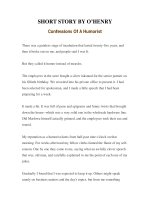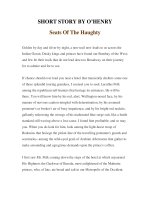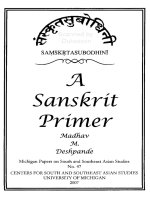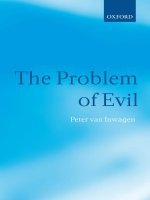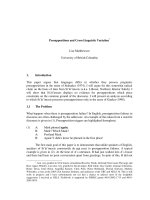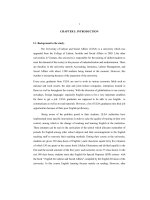Caitlin-O-Neil-University-of-St-Andrews
Bạn đang xem bản rút gọn của tài liệu. Xem và tải ngay bản đầy đủ của tài liệu tại đây (577.57 KB, 3 trang )
Characterisation Of New
Quantum Spin Liquid Materials
Caitlin O’Neil – Dr Andreas W. Rost & Dr Alexandra S. Gibbs – University of St Andrews
Background Information
•
•
•
Historically, as one approaches absolute zero, magnetic materials fully order
into one of two basic types: either ferromagnetic (spins all align parallel to each
other) or antiferromagnetic (spins all align antiparallel to each other). The
transition to these ordered states can be observed experimentally.
Quantum Spin Liquids (QSLs) are a theoretically proposed state of magnetism
[1] which, alternatively, do not order at zero temperature. There are many
types of QSLs, the two I’ll be looking at are Kitaev QSLs and Z2.
Notably, QSLs are not paramagnets (they are liquids not gases). Their spins do
have some interaction with their neighbours, see Fig 1.
Fig 1: Pictorial explanation of a QSL [2]
Research Overview
•
•
•
•
In my project I examined three main materials to see if they possess possible QSL behaviour. These were RuCl3, Ba4Ir3O10, and Li2IrO3, which were made
as powders by high temperature solid state reactions in alumina crucibles, identified as single phases using powder x-ray diffraction (XRD) and magnetic
Glove
Boxes
properties then investigated
using
an MPMS.
Due to space I will only discuss
Ba4Ir3O10 and Li2IrO3 on this poster.
are Horrible
By focusing on the magnetic susceptibility of the materials at varying temperatures and magnetic fields we obtained their Curie-Wiess Temperature, θCW
and from that the frustration parameter, f .
𝑓 = |θCW|/ TN
Where TN is the temperature where a material becomes a paramagnet.
For a QSL, f = ꚙ. If f > 100 it indicates a good QSL candidate.
Barium Iridate Samples
Ba4Ir3O10 Clean
From the optimised synthesis of powder Ba4Ir3O10 (Ba4) most of the features
from the literature [3] are confirmed. There are two clear transitions, a
structural at 142K and a magnetic at 27K, and a Curie-Wiess temperature
(θCW) of -90K. This gives f=8, which is low to be considered a QSL candidate.
Ba4Ir3O10 Test
The Ba4 was also made with a different heating schedule, where it showed
two distinct phase below T=1150oC, these were Ba4 and Ba7Ir6O19. By heating
above 1150oC the Ba4 was isolated and analysed. It showed no ordering
down to 2K, proposing QSL behaviour as suggested by Cao et al. [4].
Following this result we are clarifying which stage of the synthesis process
causes this behaviour, as it is not seen in the optimal pathway.
Ba4Ir3O10 Intermediate Heating Sample
It was suggested that the absence of ordering in the Test Sample may be due
to its heating cycle during synthesis. The test sample was heated at 50oC
intervals from 1000oC till 1200oC, where its XRD then showed it to be a single
phase. To repeat this process in the time allotted a sped up version was done
at 100oC intervals. After 1100oC these results show magnetic ordering at 23K,
so it is slightly suppressed by the intermediate steps, so this could have
caused the lack of ordering. Conversely, when the heating is continued
through to the final step of 1200oC the transition is back at 27K. This could be
because a temporary secondary phase is formed at 1100oC which disappears
at 1200oC. This happens here and not in the test because the test was heated
for longer at lower temperatures.
Ba4Ir3O10 Doped
It was thought the Test Sample might be aluminium doped from the crucible, so
the Ba4 was purposefully doped with 1% Al.
Transitions at 26K and 140K. Notably, the gradient of the inverse susceptibility of
the doped sample and test sample is the same suggesting the aluminium is
responsibly partly for that.
For the doped sample the Curie-Wiess temperature is θCW = -250K with f = 20
respectively, which is low to be consider a good QSL candidate.
1/X (emu/mole)-1
8000
Temper
4000
0
0
100
Temperature (K)
200
300
Fig. 2: Inverse magnetic susceptibility versus temperature of the Barium Iridates after final heating
Lithium Iridates with Potassium Doping
Lithium and sodium iridates have been looked at as Kitaev QSL candidates for
a few years [5], but potassium iridate has not. This is because a potassium
iridate with a honeycomb structure “does not exist”. Therefore the aim was to
create a potassium doped lithium iridate to see what effect it has of the
magnetic transitions. These samples were made using the method detailed by
O’Malley [6], but due to time limits on the project the samples could not be
fully annealed though they were synthesised (as can be seen from it’s XRD).
These results show that the K-doped sample contains both the α and β
polymorphs of Li2, while Li2 pure sample still is not fully formed. In the top
corner of Fig. 3 the two transitions; 36K for the beta and 15K for the alpha are
shown. The alpha transition is at the same temperature as the literature [5]
but he beta transition is slightly lower [7].
Further Research
•
•
•
•
Send the Ba7 & Ba4 Test sample for neutron diffraction to figure out their
structure & preform more low temperature measurements.
Carry out specific heat measurements on the samples to more clearly
identify transitions and calculate the entropy.
Try to make the K2IrO3 single phase
Send K-doped samples for neutron diffraction
References
[1] P. W. Anderson (1973), Materials Research Bulletin. 8 (2): 153–160
[2] />[3] X. Chen et al (2021) Phys. Rev. B 103; 224420
[4] G. Cao et al (2020) npj Quantum Materials 5; 26
[5] K. Mehlawat et al (2017) Phys. Rev. B 95, 144406
[6] O’Malley et al (2008) Journal of Solid State Chemistry 181; 8
[7] A. Ruiz et al (2017), Nature Communications, 8, 961
1/X (emu/mole)-1
3000
2000
1000
0
100
200
Temperature (K)
Fig. 3: Inverse magnetic susceptibility versus temperature of the Lithium Iridates during heating
Conclusion
Quantum Spin Liquids come in many forms, making a “smoking gun” of
experimental proof near impossible to find. However by using the magnetic
susceptibility to observe magnetic phase transitions one can see if something
does or does not have the potential to be a QSL. In my research I have made a
possible non-ordered phase of Ba4, a second phase Ba7 which has never had it’s
magnetic properties studied, and showed the magnetic transition slightly
decreased using a potassium doped lithium iridate.
These are three research directions I seeded in my summer project that will be
followed up by the research groups.
Acknowledgements
I would like to recognise the Carnegie Trust for their generous support on this project.
Many thanks to my supervisors Dr Andreas Rost and Dr Alexandra Gibbs.
A special recognition to Dr Alexander Browne who explained all the chemistry to me.
